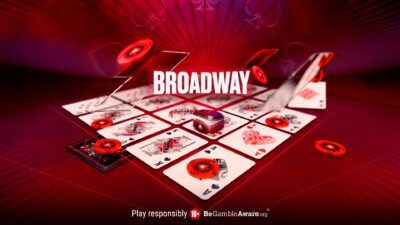Tetris ® & © 1985~2021 Tetris Holding. Opt-in required. Promotion runs Feb 15 – Mar 28, 2021. Terms apply. 18+. BeGambleAware.org. Please play responsibly. (MGA/B2C/213/2011)
As PokerStars launches its new Tetris®+ Spin & Go Leader Boards, we take a look at one of the most successful, popular, durable and enjoyable video games ever launched. Here are five fact-filled paragraphs about Tetris®:
Early days in the USSR
Tetris® was the brainchild of Alexey Pajitov, a Russian computer programmer turned game designer, who came up with the idea in 1984. He was researching artificial intelligence at the Academy of Science of the USSR at the time. Pajitov’s originally thought of making a game with “pentominoes”, which are shapes made up of five blocks, which can be arranged into 18 shapes. He simplified the idea to four-block “tetriminoes”, of which there are seven. The name Tetris® comes from the Greek word for four — “tetra” — and tennis, which was Pajitov’s favourite sport. June 6 is now World Tetris® Day, marking the anniversary of it launch 36 years ago.
The global sensation
The first games of Tetris® were played on the Elektronika 60, a computer designed and sold in the former Soviet Union, but the game surged in global popularity when it was released with Nintendo’s Game Boy in 1989. By 2015, it was an inaugural inductee into the World Video Game Hall of Fame at the Strong Museum of Play, in Rochester, NY. Other inductees in the first year were Doom, Pac-Man, Pong, Super Mario Bros. and World of Warcraft. The Tetris® brand owners, Tetris® Holding, state that billions of Tetris® games are played every year and more than 500 million Tetris® mobile games have been downloaded.
World Championship tests Tetris® players
Tetris® was one of three games played in the first Nintendo PowerFest and World Championships in 1990. According to the New Yorker magazine, the world’s best button-mashers were required to compete in a “triathlon” — “collect fifty coins in the Super Mario Bros. section, dodge green VW Beetles and negotiate a twisting racetrack at over two hundred kilometres per hour in Rad Racer, and gain as many points as possible in Tetris®, a game of strategy”.
Thinking big
The biggest game of Tetris® took place in 2014 when a team led by Frank Lee, Associate Professor of Digital Media at Drexel University, “hacked into the lighting system of a 29-storey skyscraper in Philadelphia to play Tetris® on the building’s facade,” the New York Times reported.
Research conducted at the Institute for the Future, a nonprofit think tank in Palo Alto, showed that Tetris® can potentially mitigate the psychological scars of being involved in real warfare. According to a New Yorker review of researcher Jane McGonigal’s 2015 book SuperBetter, “one study shows that when people play Tetris® within six hours of seeing a disturbing image they are much less likely to have flashbacks…McGonigal points out implications for P.T.S.D. treatment: offering victims a Tetris® console in the chopper as they leave the battlefield could spare them a great deal of suffering.”
Tetris® Glossary
They’re blocks not bricks; lines not rows. Here’s the official glossary so you can brush up on your Tetris® lingo.
All Clear: If there are no blocks anywhere on the playfield, you’re All Clear
Block: They’re not bricks. They’re not tiles. They’re not shapes. In Tetris®, they’re “Blocks”. Or Tetriminos (see below).
Broken line: Sometimes the Tetriminos don’t fit perfectly together and you might end up with a “broken line”, ie., a line that touches each side of the Matrix but has at least one gap along it.
Combo: If you clear one (or more) line, and then do it again immediately after, and possibly after that and after that again, you are creating a “combo” and your score increases exponentially
Fall speed: The speed at which the blocks appear and fall from the top of the screen. “Fall speed” increases as the game progresses, giving the player less time to manipulate blocks into the correct space.
Garbage blocks: In competitive Tetris®, where two players are playing an adjacent boards simultaneously, one player’s success puts the pressure on the opponent. If one player puts together a number of combos, “garbage blocks” appear on the opponents’ screen to hamper their play.
Ghost Piece: A Ghost Piece hovers at the bottom of a player’s Matrix and shows where its corresponding “real” piece would land if were to fall to the bottom of the screen. “It’s an absolutely invaluable tool for newcomers, as it gives them a bit more guidance for their moves,” according to the official Tetris® website.
Hard Drop: Players can force the current block down to the bottom of their Matrix by performing a “Hard Drop”. Ordinarily, the blocks gradually shift down the Matrix, and a player can also encourage them down a small amount with a “Soft Drop”. But a “Hard Drop” brings the block to the bottom with one keystroke.
High Score: Your highest score. (Are you sure you’ve played video games before?)
Hold: If you don’t want the current block, or you recognise that it’s especially useful if you save it for later, you can “Hold” it, ie., flip it out of the Matrix into the “Hold Queue”. The next block will then appear. You can bring the held block out of the Hold Queue at any time, perhaps when you can clear multiple lines at once.
Hold Queue: A place on the screen that reminds you which block you current have on Hold.
Level: As your Tetris® game goes on, and you clear lines from the Matrix, you will increase levels. As you “Level Up”, blocks begin falling more quickly, but you score more points too.
Line: A horizontal row in Tetris® is called a “line”.
Line Attack: If you’re sending Garbage Blocks to an opponent, you are performing a “line attack”.
Line Clear: When you complete a solid line of blocks, left to right, with no gaps between them, the line will disappear. That’s a “line clear”. If you clear two lines at once, that’s a “double line clear” and you can also pull off a triple or a quadruple. The latter is properly known as a “Tetris®™ Line Clear” — removing four rows at the same time.
Lock Down: When a block comes to rest at the bottom of the Matrix, or on top of blocks already there, it is locked down and can no longer be moved.
Lock Down Timer: There’s a small amount of time between a block landing on the bottom of the Matrix, or on top of another block, when it can still be moved right and left. This period of time is the “Lock Down Timer”, sometimes called the Lock Down Delay.
Marathon: A form of Tetris® gameplay where a player simply attempts to score as many points while surviving as long as possible.
Matrix: The official name for the playfield. The Matrix is to Tetris® as the “court” is to tennis.
Mino: A component part of a Tetris® block. The official name for a Tetris® block is a “tetrimino”, where “tetra” means “four”. So each block comprises four minos.
Next: Tetris® shows its players a preview of which block will appear next, after the one currently falling down the Matrix. The “Next” block is the one immediately coming up; the “Next Queue” shows the next few.
Rotate: Players can spin the blocks as they fall through the Matrix. But officially, players “rotate” the blocks clockwise or counterclockwise.
Soft Drop: Players can hasten the natural drop of a block by means of a “Soft Drop”. This brings the block down the Matrix slightly quicker than it would move under gravity alone, and a player can stop a soft drop if he or she wants to rotate it further.
T-Slot: A formation of blocks into which at least three of the four minos in a T-shaped tetrimino will fit.
Tetrimino: A full Tetris® block, comprised of four minos.
Back to Top








